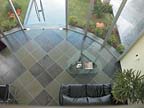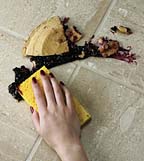
Stone tiles are being used more than ever on projects in both residential and commercial applications. Some of these stones can be tricky to install and even trickier to maintain. In this article, I am not going to touch on the stone tile surface maintenance issue, but rather, on the trends regarding installation products and the techniques used to install stone floors. One of today's most noticeable trends is that the tiles being used for floors are growing in facial dimension size, but shrinking in profile thickness. Providing a permanent bond and preventing cracking is the primary goal for a successful installation.

Large-format stones
As the facial dimensions of stone tiles continue to grow, it becomes very important to make sure that the stone is well supported by the adhesive mortar. For the purposes of this article, we will assume that the substrate to receive the stone is appropriate (meeting deflection standards and properly prepared). Most stones vary in thickness; some more than others. The adhesive mortar needs to accommodate the variance in the stone tile's thickness and also be able to support and bed the stone under its entire area. Some mortars just simply cannot do this. It is vital to use a suitable marble and granite mortar that is designed to not only bed the stone properly, but is also designed to support the weight of the stone. Most adhesive manufacturers have products that are specifically designed to be used with stone.Prevent cracking
Cracked stone flooring is a negative image that all of us in the industry want to avoid. In order to prevent cracking of floors, we have to make sure of several things. We will again assume that the substrate to receive the stone is appropriate (meeting deflection standards and properly prepared). In addition, proper installation techniques are required in order to ensure that stone tiles do not crack. We can start by using an anti-fracture membrane over the substrate. These membranes can prevent shrinkage cracks caused by concrete curing, and other small hairline “spider web†cracks from transmitting through the stone surface. These membranes are generally very easy to apply; some are liquid roller applied, while others are peel-and-stick type sheet products. These materials can be used to treat existing cracks on the substrate and also to guard against future cracks that may develop over time. Once the anti-fracture membrane is in place, good installation techniques should be followed when installing the stones. For thin-bed and medium-bed installations, this includes using the appropriate-sized notch trowel and back-troweling the stones to ensure complete bedding of the stones with no voids. It is always a good idea to periodically pull up a freshly installed stone to verify the coverage and mortar transfer. All of these methods and practices are all the more important if the stones that are being used are thin and fragile. The thinner the stone, the more effort is required to ensure a good installation.Backings on stone
Take a look at 10 different stone tiles. You may be surprised to see how many of these have various types of backings on them. These backings can be composed of polyester or epoxy backings with fiber mesh scrims to another thinly cut stone laminated to the back of another stone. The backings are also designed to provide rigidity and to stabilize some of the more fragile stone types used on floors. However, these backings can present some challenges to the installer. We would first suggest that you contact the stone supplier to see if they have any special instructions from the manufacturer. This may provide direction for which type of adhesive mortar should be used for the stone. In many instances, if the backing on the stone is some sort of resin backing, more often than not it should be installed with an epoxy-based adhesive. Some stone manufacturers will broadcast sharp sand or other aggregate into the resin. This facilitates better mechanical grip or adhesion to the mortar. When this is the case, a latex-fortified mortar may be used.Other stone issues
There are several other issues to consider when installing stone flooring. One issue is the stability of the stone itself. If the stone is water or moisture sensitive and prone to curling (usually green marbles and some agglomerates), a 100% solids epoxy adhesive should be used. Use a white-colored adhesive mortar for light- or white-colored stones. Some installers will only use a white mortar regardless of the stone color to avoid confusion on the project site.
Always honor expansion joints that may exist in the substrate and bring them through the stone finish. Movement joints should also be placed at the perimeter of the installation, as well as in the field. A good rule of thumb is to follow the “Handbook for Tile Installations (NATC)†guidelines outlined in Expansion Joint Detail EJ171. Although this is a publication for the tile industry, the Marble Institute of America also points to this detail in its installation manual. Use a suitable flexible sealant that is non-staining and will hold up to the traffic and maintenance that the area will see. Note that most acrylic-type colored caulks are not suitable for these installations.
Radiant heat issues
There is also a growing trend to install radiant heating under stone floors. There are a few things to consider when installing stone over radiant heated floors, whether they may be electric or liquid in pipe systems. The heating system should always be tested to ensure that it is functioning correctly prior to the installation of the stone. Then the heating system should be turned off and allowed to cool prior to the installation of the stone. Follow the same practices that have been outlined above for the installation. It is always a good idea to include a membrane in the installation system for these applications. If the installation is in an area where water can get on the floor, a waterproofing membrane should be used. An added benefit of using a waterproofing membrane is that many membranes act as anti-fracture membranes as well. An anti-fracture membrane should always be considered for heated floors. Thermal expansion and contraction of the stone caused by the cycling of the heating system can create stresses on the floor that may develop into hairline cracks in the stone finish. The use of these membranes can help to prevent this from occurring. In addition, it is a good practice to use a latex fortified thin-bed or medium-bed mortar that is flexible in nature to deal with the greater probability of expansion and contraction that the installation can undergo. Check with your adhesive and membrane manufacturer for a compatible membrane and adhesive system that is backed with a comprehensive warranty.Grout for stone
As the finishing touch, the grout used should really complement the stone installation. Many of the problems that occur with stone installations are related to the grout, whether it is color consistency or durability. A compatibility test should always be performed on the stone with the grout that will be used. Some stones may require that a sealer be applied to the face of the stones to make the grouting and clean-up process easier. Some stones may be stained by the grout if the sealer precaution is not followed. If a Portland cement-based product is chosen, the use of a high-quality latex-fortified grout is always a good idea. There have been great strides with new products in this area. For even better performance, there are now new types of grouts that can be used with stone that will not experience all of the typical inherent problems that Portland cement-based grouts do. Some of these products include a unique cross-linking technology grout and various epoxy-based grouts.Some of the advantages of these cross-linking technology grouts and epoxy grouts are as follows:
- They contain no Portland cement, which can lead to efflorescence or mottling and other color problems associated with Portland cement-based grouts.
- These grouts are very dense and have an extremely low porosity rate, which makes them extremely resistant to staining.
- They provide uniform color -- reducing color shade variations.
- They are very durable -- will not crack or peel.
- They are easy to clean and maintain due to their smooth texture.
- They never require a grout sealer.
- Generally, the grout is as dense and durable as the stone itself.
We are all glad to see stone consumption continue to rise. There are many new trends with installation materials and techniques that are always becoming available. These materials and techniques are created with the intent of making the installation easier and permanent. Check with your stone installation manufacturers for their suggestions on new products and new installation trends and techniques.